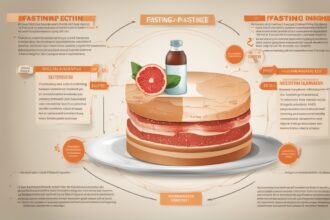Fasting and dietary restriction have gained significant attention in recent years for their potential health benefits, particularly in the realm of reducing inflammation and swelling in the body. One of the most promising approaches to managing inflammation is through the practice of reducing swelling through dietary restriction. This method involves limiting certain foods or overall caloric intake to help the body combat inflammatory responses. In this article, we’ll explore how dietary restriction can play a pivotal role in alleviating swelling and promoting overall wellness.
What Is Dietary Restriction and How Does It Relate to Swelling?
Dietary restriction refers to the intentional reduction of food intake or the elimination of specific food groups to achieve health benefits. This can include practices like intermittent fasting, calorie restriction, or avoiding inflammatory foods such as processed sugars and trans fats. Swelling, often a visible sign of inflammation, occurs when the body responds to injury, infection, or stress by increasing blood flow and fluid to the affected area. Chronic inflammation, however, can lead to persistent swelling and is linked to conditions like arthritis, heart disease, and autoimmune disorders.
By focusing on reducing swelling through dietary restriction, individuals can potentially lower the body’s inflammatory markers. Studies suggest that fasting and controlled eating patterns reduce the production of pro-inflammatory cytokines, which are proteins that contribute to inflammation. When the body is given a break from constant digestion, it can focus on repair and recovery processes, which may help mitigate swelling.
The Science Behind Fasting and Inflammation Reduction
The connection between fasting and inflammation reduction lies in the body’s metabolic and immune responses. During periods of dietary restriction, the body enters a state of ketosis, where it burns fat for energy instead of glucose. This metabolic shift has been shown to decrease levels of inflammatory markers like C-reactive protein (CRP) and interleukin-6 (IL-6). Additionally, fasting triggers autophagy, a cellular cleanup process that removes damaged cells and reduces inflammation.
For those aiming at reducing swelling through dietary restriction, this scientific foundation offers hope. Research indicates that even short-term fasting can lower inflammation in the body, which may result in decreased swelling in joints and tissues. This approach is particularly beneficial for individuals with chronic inflammatory conditions, as it provides a natural way to manage symptoms without relying solely on medication.
Types of Dietary Restriction for Reducing Swelling
There are several forms of dietary restriction that can aid in reducing swelling through dietary restriction. Each method has unique benefits and can be tailored to individual needs and lifestyles. Here are a few popular approaches:
- Intermittent Fasting (IF): This involves cycling between periods of eating and fasting, such as the 16:8 method (16 hours of fasting, 8 hours of eating). IF has been shown to reduce inflammation and improve metabolic health.
- Calorie Restriction (CR): Reducing daily caloric intake by 20-30% without malnutrition can lower inflammatory markers over time.
- Anti-Inflammatory Diets: Eliminating foods like refined sugars, processed meats, and dairy while focusing on whole foods such as vegetables, fruits, and omega-3-rich fish can directly target swelling.
- Water Fasting: A short-term fast involving only water intake can reset the immune system and reduce inflammation, though it should be done under medical supervision.
Choosing the right method depends on personal health goals and existing medical conditions. For more insights on fasting methods, check out our detailed guide on Intermittent Fasting for Beginners.
Foods to Avoid and Include for Swelling Reduction
When practicing reducing swelling through dietary restriction, the quality of food consumed during eating windows is just as important as the restriction itself. Certain foods are known to exacerbate inflammation and swelling, while others can help combat it.
Foods to Avoid: Processed foods, sugary drinks, trans fats, and excessive red meat can trigger inflammatory responses. These foods increase the production of pro-inflammatory compounds in the body, worsening swelling.
Foods to Include: Anti-inflammatory foods like leafy greens, berries, fatty fish, nuts, and seeds should be prioritized. These foods are rich in antioxidants and omega-3 fatty acids, which counteract inflammation. Turmeric, ginger, and green tea also have potent anti-inflammatory properties.
For a deeper dive into crafting an anti-inflammatory diet, read our post on Top Anti-Inflammatory Foods to Include in Your Diet.
Potential Risks and Considerations of Dietary Restriction
While reducing swelling through dietary restriction offers numerous benefits, it’s not without potential risks. Prolonged fasting or extreme calorie restriction can lead to nutrient deficiencies, fatigue, or weakened immunity if not done correctly. It’s also important to note that dietary restriction may not be suitable for everyone, especially pregnant women, individuals with eating disorders, or those with certain medical conditions like diabetes.
Before embarking on any fasting or dietary restriction plan, consult with a healthcare professional or nutritionist. They can help create a safe and effective strategy tailored to your needs. Learn more about safe fasting practices in our article on Fasting Safely: Tips and Precautions.
Real-Life Benefits and Success Stories
Many individuals have experienced significant improvements in swelling and overall health by adopting dietary restriction. For instance, people with rheumatoid arthritis have reported reduced joint swelling after implementing intermittent fasting or anti-inflammatory diets. Similarly, those with chronic bloating or edema have noticed a decrease in fluid retention through calorie restriction and mindful eating.
These success stories highlight the potential of reducing swelling through dietary restriction as a sustainable approach to managing inflammation. While results vary, combining dietary restriction with other healthy lifestyle choices like regular exercise and stress management can amplify the benefits. Explore more personal experiences in our piece on Fasting Success Stories: Real People, Real Results.
Disclaimer: The information provided in this article is for educational purposes only and should not be considered medical advice. Dietary restriction and fasting may not be suitable for everyone, and individual results can vary. Always consult with a healthcare professional or registered dietitian before making significant changes to your diet or lifestyle, especially if you have pre-existing health conditions or are on medication.
References
- de Cabo, R., & Mattson, M. P. (2019). Effects of Intermittent Fasting on Health, Aging, and Disease. New England Journal of Medicine.
- Harvard Health Publishing. (2020). Foods that Fight Inflammation.
- Mayo Clinic. (2021). Anti-Inflammatory Diet: What to Know.
- Longo, V. D., & Mattson, M. P. (2014). Fasting: Molecular Mechanisms and Clinical Applications. Ageing Research Reviews.
- WebMD. (2022). Anti-Inflammatory Diet: Road to Good Health.
This content is for informational purposes only and not a substitute for professional advice.






